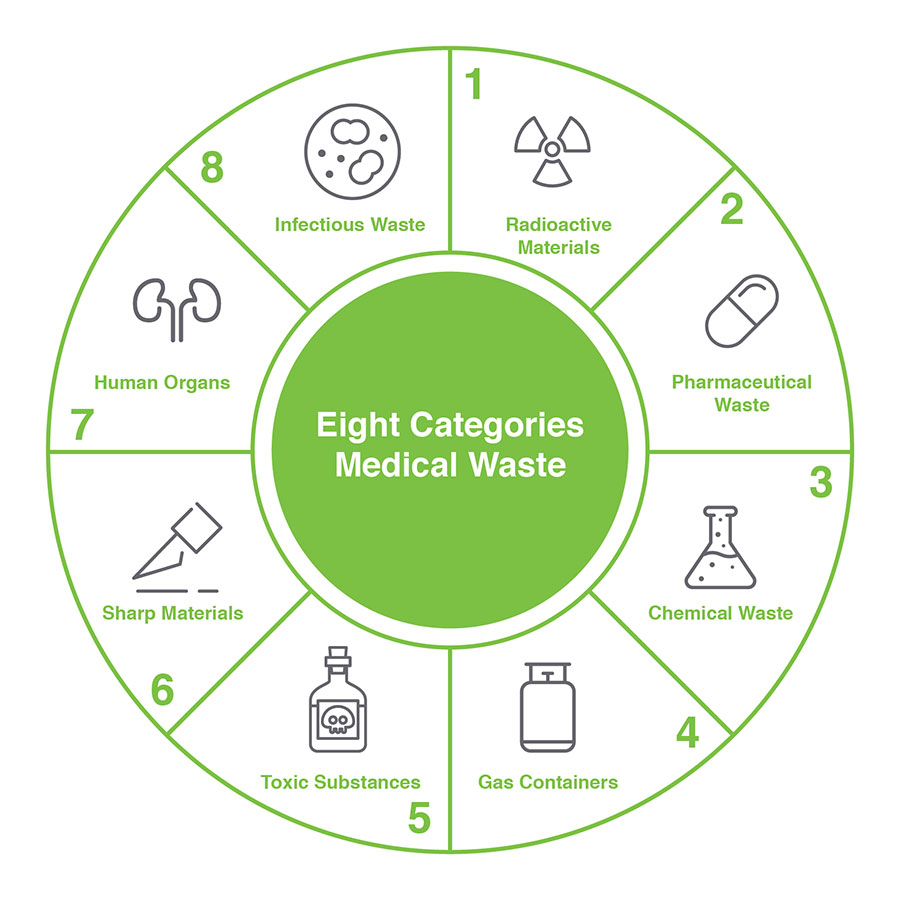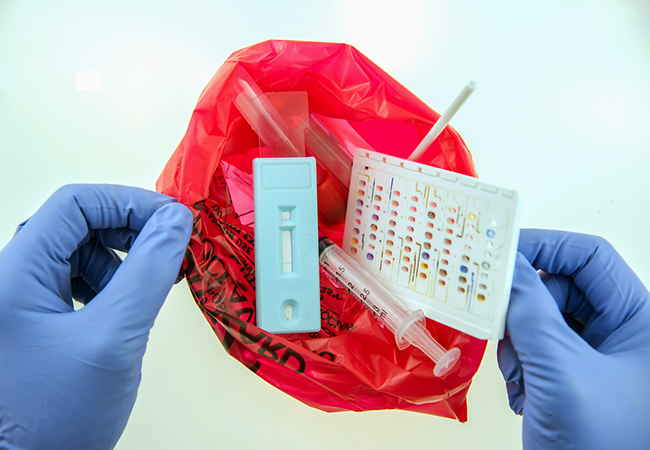Medical Waste Removal Mastery: Where Service Excellence Meets Health And Wellness Requirements
Wiki Article
Efficient and Eco-friendly Medical Waste Disposal Solutions
In the ever-evolving field of medical care, the issue of medical waste disposal stays a topic of vital significance. As medical facilities, clinics, and other healthcare facilities strive to give quality client treatment, they need to also attend to the obstacle of efficiently and responsibly disposing of their waste.Waste Segregation Practices
Reliable waste segregation methods are crucial to guarantee the correct and secure disposal of clinical waste. Clinical waste, that includes materials infected with possibly contagious compounds, have to be taken care of in a manner that minimizes the risk of damage to both public wellness and the setting. Correct waste segregation plays a critical duty in attaining this objective.Waste partition involves the splitting up of different kinds of waste based upon their characteristics and possible threats. This process guarantees that each type of waste is treated and disposed of appropriately (medical waste disposal services with WasteX). It starts at the factor of generation, where healthcare centers must have designated containers and containers for different waste classifications, such as sharps, contagious waste, pharmaceutical waste, and non-hazardous waste
By segregating clinical waste at the source, medical care carriers can stop cross-contamination and reduce the threat of exposure to transmittable agents. This technique also helps with the recycling and recovery of specific materials. As an example, setting apart and reusing tidy plastics and glass lowers the demand for basic materials and minimizes the ecological impact of clinical waste disposal.

Autoclaving and Sanitation Strategies
In order to make sure the secure and correct disposal of medical waste adhering to reliable waste partition practices, healthcare facilities must utilize autoclaving and sterilization methods. Autoclaving is an extensively made use of approach that uses high-pressure vapor to sterilize medical waste. This procedure involves positioning the waste in a chamber and subjecting it to a combination of heat and stress, which properly eliminates microbes and provides the waste risk-free for disposal. Autoclaving is specifically reliable in decontaminating things such as medical tools, lab devices, and specific kinds of medical waste that can withstand high temperatures. medical waste disposal services with WasteX.Another frequently used sanitation strategy is chemical sterilization. This entails treating the waste with chemicals such as ethylene oxide or hydrogen peroxide, which eliminate microbes by disrupting their mobile framework. Chemical sterilization is often utilized for heat-sensitive products or products that can not hold up against the heats of autoclaving. Nonetheless, it is very important to keep in mind that chemical sanitation requires proper handling and disposal of the chemicals made use of, as they can be unsafe to human health and the atmosphere otherwise managed appropriately.
On-Site Waste Treatment Systems
Healthcare facilities have implemented on-site waste treatment systems to address the disposal of medical waste in a safe and efficient way. These systems give a affordable and convenient solution for taking care of clinical waste generated within the facility. On-site waste treatment systems use different innovations to deal with and dispose of medical waste on-site, minimizing the need for transport to off-site centers.One frequently utilized on-site waste therapy system is the microwave innovation. This innovation utilizes microwave energy to decontaminate and decontaminate medical waste, reducing its quantity and making it safe for disposal. An additional system is the chemical sanitation technology, which involves dealing with medical waste with chemicals to kill virus and decrease its hazardous nature. This technique is particularly efficient for fluid medical waste.
On-site waste therapy systems use numerous advantages. They eliminate the danger of clinical waste being messed up throughout transport, lowering the possibility for contamination and exposure to dangerous materials. In addition, these systems aid medical care centers comply with waste management policies by providing a convenient and effective disposal technique. On-site treatment systems minimize the general environmental impact of medical waste by minimizing transport and the requirement for garbage dump area.
Recycling and Repurposing Initiatives
As health care centers make every effort for sustainable waste administration methods, they are progressively checking out recycling and repurposing efforts as a way of lowering the ecological impact of medical waste. Recycling and repurposing initiatives involve discovering innovative methods to recycle or transform clinical waste into new products or products. This not just assists to lessen the volume of waste that winds up in burners or garbage dumps however also minimizes the intake of resources and energy required for making brand-new products.
One instance of reusing in the health care market is the reprocessing of single-use medical tools. These tools, such as surgical instruments or catheters, are usually disposed of after a single usage. Nevertheless, advancements in modern technology and strict sterilization procedures have made it feasible to securely clean, decontaminate, and recycle these gadgets multiple times. This not just lowers the amount of waste generated however also conserves medical care centers substantial costs connected with buying check that brand-new devices.
Another reusing initiative includes the recycling of plastic containers, such as drug containers or syringe casings. These containers can be gathered, arranged, and sent out to recycling facilities where they are processed, melted down, and changed right into new plastic products. This helps to conserve resources and reduce the demand for virgin plastic manufacturing.
In addition to recycling, repurposing efforts involve discovering different usages for clinical waste. For instance, shredded paper waste from clinical documents or product packaging materials can be repurposed as bedding product for pets or as insulation material (medical waste removal services). Organic waste such as food scraps from medical care centers can be composted and made use of as plant food in gardens or farming areas.

Renewable Resource Solutions
One efficient approach to alleviating the environmental impact of healthcare operations involves carrying out renewable resource services. Healthcare centers, such as healthcare facilities and facilities, take in considerable amounts of power for various objectives, consisting of lighting, heating, air conditioning, and running medical tools. By transitioning to eco-friendly power sources, these facilities can substantially decrease their carbon footprint and add to a much more sustainable future.

Applying renewable power remedies in health care centers not only decreases greenhouse gas discharges but additionally supplies long-lasting price financial savings. While the first financial investment in renewable resource framework may be higher, the long-term functional prices of sustainable power systems are significantly lower contrasted to traditional fossil fuel-based energy resources. Furthermore, renewable resource systems are reputable and can offer a undisturbed and steady power supply, making sure continuous healthcare services even throughout power outages or emergency situations.
Verdict
In verdict, implementing reliable and ecologically pleasant clinical waste disposal options is important for maintaining a lasting health care system. By adopting waste partition techniques, autoclaving and sterilization methods, on-site medical waste disposal services with WasteX waste therapy systems, reusing and repurposing efforts, and renewable power solutions, health care centers can substantially reduce their environmental influence.It begins at the point of generation, where medical care facilities must have marked bins and containers for various waste groups, such as sharps, infectious waste, pharmaceutical waste, and non-hazardous waste.
In order to make sure the appropriate and risk-free disposal of medical waste following reliable waste partition techniques, health care centers must use autoclaving and sanitation strategies.Healthcare facilities have Learn More Here implemented on-site waste treatment systems to deal with the disposal of medical waste in a secure and efficient fashion. On-site waste therapy systems make use of various technologies to dispose and treat of medical waste on-site, lessening the demand for transport to off-site centers.
As healthcare facilities aim for lasting waste administration techniques, they are significantly discovering recycling and repurposing campaigns as a method of minimizing the ecological influence of clinical waste. - medical waste removal near me
Report this wiki page